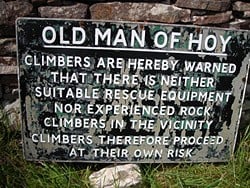
Such badly organised starts are characteristic of climbing trips the world over and this one was shaping up to be no exception. Throwing the kit in the back of the van, I pick Mark up on time and we begin our long journey north. Our destination is the last page of the road atlas, the island of Hoy in the Orkneys. It is there we will find the Old Man of Hoy, at 137m the largest sea stack in the British Isles and magnet for sea cliff climbers.
As we drive along the Welsh coast, we talk excitedly about the route, look at ferry timetables and try to cobble together a plan for the next few days. The first few hours fly by and we pass Gretna Green and into Scotland with no major problems. The sun is starting to set as we pass Glasgow but, two days from the summer solstice, it lingers on the horizon for much of the night. Even when we stop for fuel in Inverness at 10pm there is still enough daylight to read the road atlas. This turns out to be a little depressing when we discover we still have another three pages of map to go.

A pick up truck and the post van prove more effective than an alarm clock and we descend into the depths of the ferry just before eight, heading straight to the on-board café for the first proper food since leaving Wales. Despite the sea of grease it is swimming in, the fry-up is gratefully devoured just in time to get on deck to catch our first glimpse of the Old Man.
From the sea, it is dwarfed by St Johns head, the third largest sea cliff in the UK. However, as the angle changes, its true shape is revealed, a top heavy, fragile looking tower. It's horizontal strata give the impression of a gothic skyscraper while the Orchadian sandstone suggests it has been constructed by a child on the beach. It is difficult to imagine a less appealing combination for the first glimpse of a climb.
As we round the corner, the stack disappears from sight and Stromness harbour appears. The captain docks with practised ease and we are coughed up from the ferries belly, blinking in the unexpected bright sunshine. The small roads of the island are empty and we are soon in Houghton. Abandoning the van, we heave overfull rucksacks onto our backs and stagger onto the ferry to Hoy. The views from the deck make up for the cold wind and we take a few moments to actually read the topo for the route for the first time.
Lyness harbour is little more than the aquatic equivalent of a bus stop and when the ferry has departed, we are left with our pile of kit on the dock wondering quite what to do next. There is a list of taxi firms pinned to the wall above the payphone and I start at the top of the list and work my way down. The first two are engaged so it is a great relief when a soft Orchadian accent answers the third. "It's my husband you want. He'll be with you when he's finished the washing up".
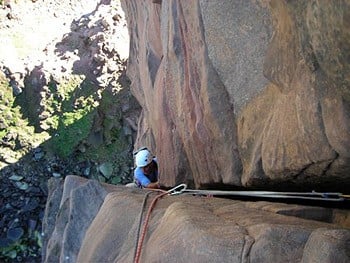
There is no one around at the hostel when we arrive so we assume it will be okay to stay and dump our overnight stuff. Our original plan was to have a look at the route that night and then climb it in the morning but the sun is shining, and despite only 3 hours sleep, we both feel pretty good. Heaving our now much lighter packs onto our backs we begin the climb up and over the headland. The views back over the bay are stunning, with the bone white sand separating the green hills from the deep blue sea.
As we follow the well defined track, the excitement begins to mount. Just two days ago, we had hatched a half-baked plan to go and climb "some sea stacks" and, in front of me, the largest one in the UK is just starting to appear over the horizon. As we get closer, the section we can see becomes clearer and we can make out more details, although nine tenths of it is lurking like an iceberg below the top of the cliff.
Arriving at the edge of the cliff we can see the whole of the stack and the face we intend to climb for the first time. With the top of it at the same level as we are, it looks like we could take a running jump and clear the 140m drop. The route itself is obvious from where we are standing, a scramble up to a large ledge, a traverse into an off-width crack, through an overhang, over a series of ledges and then up a huge open book corner. The top looks dangerously unstable with nowhere to belay but we file such thoughts under "things to deal with later".
With some difficulty we locate the descent path which is well defined once we are on it and we follow a precipitous, winding route down to sea level. It doesn't take long to sort out the gear and I lead off up the first pitch. The rock is much sounder than it looked from the ferry and handholds are plentiful, making it a joy to climb. There is plenty of protection and the large belay ledge comes all to soon.
Bringing Mark up, I take the time to absorb the surroundings. The bright sunlight picks out the colours in the red cliff and the fulmars squawk their annoyance at our invasion of their normally peaceful territory. The slight swell we had felt on the ferry is causing waves to lap at the boulders on the shore and the noise, so often intimidating on sea cliff climbs is, for once, quite soothing.

The next pitch is a series of connecting ledges and is dispatched without too much difficulty. At the belay a fulmar decides that Mark has got too close and warns him by vomiting a healthy dose of fish oil onto his shirt. This signals the opening bout in a stand-off that will last for the next twenty minutes. Extending the belay so I don't have to get too close, Mark sets off up the open book corner for the top. With one eye on him, I use the other to monitor the crafty fulmar for any signs that he wishes to start round two.
It is with some relief that I hear the words "Climb when ready" and I can free myself from the belay and make my escape from the belligerent looking bird. The corner is one of the finest pitches I have every climbed. At sea level, on its own, it would merit three stars. A hundred and ten metres up at the tip of the sea stack it is the ideal way to round off a superb route. As I bridge my way up, handholds seem to appear exactly where I want them; never hard, it requires thought rather than strength. Towards the top, the crack in the back of the corner splits the stack completely in two and I can see the sea on the other side. A light breeze is blowing through it, giving the peculiar sensation that Old Man is swaying.
Pulling over the top I see Mark with a big smile on his face. A feeling of elation, touched with relief surges up through my body, something which only happens on climbs that have meant something to me. As I stand up to get a better view Mark points at his watch. I struggle to understand what he means at first, looking at mine in a attempt to understand. Then I realise, it is 4.30pm. We left home exactly twenty four hours ago.
Mark Reeves has put together movie short, 24 hours-the Old Man of Hoy, you can see it at You Tube.
Getting to Hoy
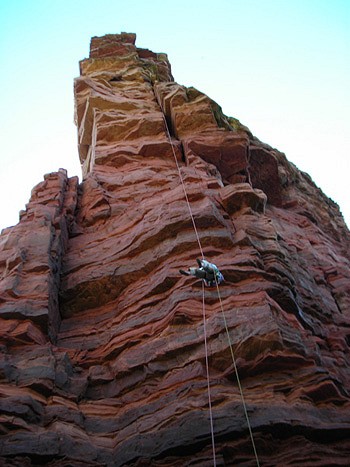
Ferries to Orkney go from Scrabster near Thurso to Stromness. Northlink Ferries (0845 6000 449 www.northlinkferries.co.uk.) runs the service several times daily, it takes 1.5 hours and costs £29.60 return . On the way it passes the Old Man, providing a good view of the stack and of the descent route down to it.
Once in Stromness, just outside the ferry terminal is Brass's Taxis (01856 850750). A taxi to the ferry at Houghton is around £13 and takes about 15mins. If you have time to kill, Julie's Cafe on the waterfront does a great breakfast.
The ferry to Hoy from Houghton is run by Orkney Ferries (01856 872044 www.orkneyferries.co.uk) and costs £6.50 per person return. 30 minutes later you arrive in Lyness and it's worth having booked a taxi to meet you and take you to Rackwick Bay (£15), although it is possible to get one on arrival. Mr T Williams of Bu Farm (01856 791263) runs a service, he was the driver for the BBC on the 1967 ascent of the Old Man and knows plenty about the stack and the climbers who have attempted it.
At Rackwick Bay there is a bothy and a YHA Hostel. The bothy is free and on the beach, about a mile from the start of the path to the Old Man. The hostel is next to the path and is well equipped, beds are £9.60 per person per night or it also allows camping in it's grounds. The warden can be reached on (01856) 873535.
The Walk In
Leaving from the hostel car park, with it's stark warning sign to climbers, go towards the headland, following signs and the obvious path. You will climb steeply at first then more gradually over the headland and along the coast. After a mile or so the top of the Old Man can be seen over the skyline and after 45 minutes you will reach a well defined viewpoint next to the stack.
The descent path starts at the second obvious gully, about 100m right of the stack looking out. After a steep downclimb, the path traverses back towards the Old Man, narrow and precipitous but well defined. It finally zig zags it's way down to sea level at a boulder bridge connecting the stack to the main land. The first pitch starts from the end of the bridge.
Equipment
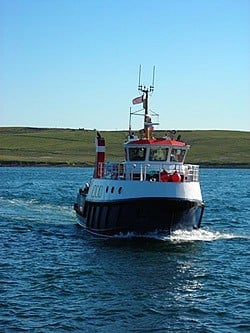
The Original route goes in 4 pitches if you have 60m ropes, and double ropes are essential to allow an abseil descent. If you have 60m ropes, the last two guidebook pitches can be run and it is possible to abseil straight to the ground from the top of pitch two. If you don't have 60m ropes it will be necessary to leave a guideline in place on pitch two, as per the guidebook.
Much of the route is an off-width crack, so large cams are essential, up to and including size 5. Long extenders will reduce your rope drag as some of the pitches meander over ledges and a few slings are useful to thread the wooden blocks in-situ from the first ascent.
There is a lot of abseil tat in-situ at the belays but take your own as some of it is quite old. It may be worth taking a knife to remove the older stuff, allowing you to thread the over stuffed holes on the pegs. A couple of sacrificial carabiners can make pulling the rope much easier, there are many in place but they corrode quickly in the salt air.
Mobile phone reception is reasonable across the Orkneys and can make booking taxis, etc much easier.
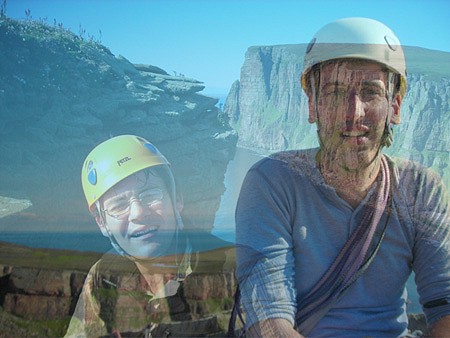
Sam Moore (www.samsthings.co.uk)) is an outdoor instructor for Boulder Adventures (www.boulderadventures.co.uk) in Llanberis, North Wales. Mostly seen on the river, he can be tempted onto the rock by a promise of an adventure.

Comments